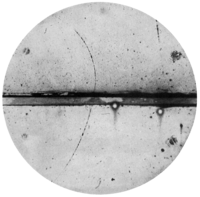
Back بوزيترون Arabic پوزيطرون ARY Positrón AST Pozitron Azerbaijani Пазітрон Byelorussian Позитрон Bulgarian পজিট্রন Bengali/Bangla Pozitron Breton Pozitron BS Positró Catalan
 Cloud chamber photograph by C. D. Anderson of the first positron ever identified. A 6 mm lead plate separates the chamber. The deflection and direction of the particle's ion trail indicate that the particle is a positron. | |
| Composition | Elementary particle |
|---|---|
| Statistics | Fermionic |
| Generation | First |
| Interactions | Gravity, electromagnetic, weak |
| Symbol | e+ , β+ |
| Antiparticle | Electron |
| Theorized | Paul Dirac (1928) |
| Discovered | Carl D. Anderson (1932) |
| Mass | me 9.1093837139(28)×10−31 kg[1] 5.485799090441(97)×10−4 Da[2] 0.51099895069(16) MeV/c2[3] |
| Mean lifetime | stable (same as electron) |
| Electric charge | +1 e +1.602176634×10−19 C[4] |
| Spin | 1/2 ħ (same as electron) |
| Weak isospin | LH: 0, RH: 1/2 |
The positron or antielectron is the particle with an electric charge of +1e, a spin of 1/2 (the same as the electron), and the same mass as an electron. It is the antiparticle (antimatter counterpart) of the electron. When a positron collides with an electron, annihilation occurs. If this collision occurs at low energies, it results in the production of two or more photons.
Positrons can be created by positron emission radioactive decay (through weak interactions), or by pair production from a sufficiently energetic photon which is interacting with an atom in a material.
- ^ "2022 CODATA Value: electron mass". The NIST Reference on Constants, Units, and Uncertainty. NIST. May 2024. Retrieved 18 May 2024.
- ^ "2022 CODATA Value: electron mass in u". The NIST Reference on Constants, Units, and Uncertainty. NIST. May 2024. Retrieved 18 May 2024.
- ^ "2022 CODATA Value: electron mass energy equivalent in MeV". The NIST Reference on Constants, Units, and Uncertainty. NIST. May 2024. Retrieved 18 May 2024.
- ^ "2022 CODATA Value: elementary charge". The NIST Reference on Constants, Units, and Uncertainty. NIST. May 2024. Retrieved 18 May 2024.